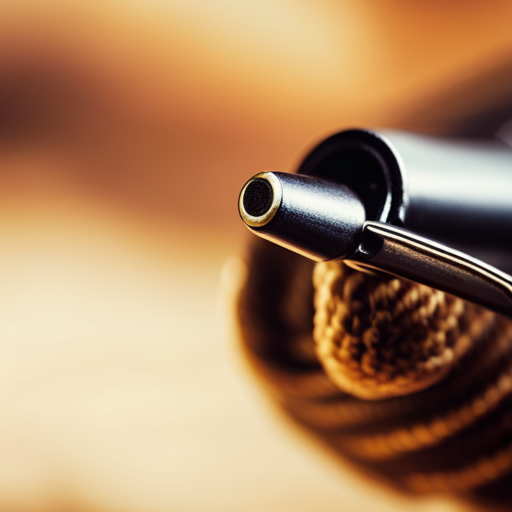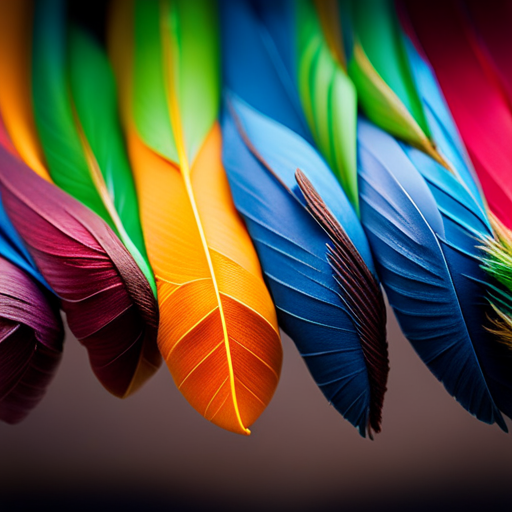As a fly fisherman carefully selects his artificial fly to match the natural insects on the water, the role of yarn in fly tying becomes paramount.
This article delves into the intricate details of how yarn, often overlooked, plays a crucial role in creating lifelike imitations of insect bodies.
From its diverse color options to its ease of use, yarn enhances the effectiveness of flies, ultimately fooling even the most discerning of fish.
Yarn: An Essential Fly Tying Material
Yarn is an indispensable material in the art of fly tying, contributing to the construction of durable and lifelike fly patterns. When it comes to yarn types for fly tying, there is a wide variety available, each serving specific purposes.
Antron yarn, for instance, is commonly used for its ability to create translucent and shiny bodies on flies, while wool yarn is valued for its water-absorbing properties, making it suitable for creating buoyant dry flies. Additionally, synthetic yarns like polypropylene are popular for their ability to repel water, making them ideal for tying floating flies. These different yarn types allow fly tiers to customize their patterns to suit specific fishing conditions, whether it’s imitating aquatic insects or small baitfish.
Yarn finds various applications in fly tying, from creating bodies and thoraxes to forming wings and tails on flies. Its versatility and ease of use make it a staple material for both novice and experienced fly tiers. Understanding the different yarn types and their applications is crucial for achieving the desired look and behavior of the fly in the water, ultimately increasing the angler’s chances of a successful catch.
Mimicking Natural Insect Bodies
As we examine the role of yarn in fly tying, it’s crucial to consider how it can be used to mimic natural insect bodies. By imitating insect anatomy and achieving lifelike textures, fly tyers can create highly effective imitations that attract fish.
Understanding the techniques for replicating the appearance and texture of natural insect bodies is essential for successful fly tying.
Imitating Insect Anatomy
The imitation of insect anatomy in fly tying is crucial for creating lifelike imitations of natural insect bodies. To achieve this, fly tiers focus on imitating insect movement and creating lifelike patterns. This involves meticulous attention to detail to mimic the segmented bodies, legs, and antennae of insects.
To achieve realistic imitations, fly tiers often use specific fly tying materials such as yarn, thread, and synthetic materials. Additionally, they may employ techniques like dubbing, wrapping, and shaping to accurately replicate the intricate features of natural insects.
Achieving Lifelike Textures
Mimicking natural insect bodies in fly tying involves precision and attention to detail. Achieving lifelike textures is crucial for creating realistic fly patterns that effectively imitate insect movements. To achieve this, it is essential to use yarn and materials that can create lifelike movement in the water.
Incorporating materials with different textures and densities can help achieve a more realistic appearance, mimicking the natural movements of aquatic insects. Additionally, using contrasting colors in the yarn can help create depth and dimension, making the fly pattern more visually appealing and realistic.
Diverse Color Options for Realism
Diverse color options play a crucial role in achieving realism when using yarn for fly tying. Realistic coloration is essential for creating flies that mimic the natural appearance of insects, enticing fish to strike. To achieve this, fly tyers have a wide array of color options at their disposal, allowing for precise imitation of various insects and aquatic life.
When considering diverse color options for realism in fly tying, it’s important to take into account the following:
-
Natural Color Variations: Mimicking the subtle variations in color that are present in natural insects and aquatic life is crucial for creating realistic fly patterns. Utilizing yarn in an array of shades that closely resemble the natural colors of insects can greatly enhance the fly’s appeal to fish.
-
Matching Local Prey Species: Understanding the prevalent insect species in the local ecosystem and choosing yarn colors that closely resemble them can significantly improve the effectiveness of fly patterns. By accurately replicating the colors of local prey species, fly tyers can increase their chances of attracting fish.
Ease of Use and Versatility
Utilizing yarn for fly tying offers an unmatched level of ease of use and versatility, making it an indispensable material for creating a wide range of fly patterns. Yarn is highly durable, allowing for the creation of flies that can withstand multiple strikes from fish without falling apart. Its durability makes it an excellent choice for tying flies that will be used frequently or in rough water conditions. Additionally, yarn is incredibly versatile in terms of tying techniques. It can be used to create various body shapes and textures, and it can be easily manipulated to achieve different effects. Whether creating nymphs, dry flies, or streamers, yarn can be adapted to suit the specific needs of each fly pattern. This versatility allows fly tiers to experiment with different techniques, leading to the development of innovative fly patterns. The table below provides a comparison of yarn with other commonly used fly tying materials, highlighting its superior ease of use and versatility.
| Aspect | Yarn | Other Material 1 | Other Material 2 | Other Material 3 |
|---|---|---|---|---|
| Durability | High | Medium | Low | Medium |
| Tying Techniques | Versatile | Limited | Limited | Versatile |
Enhancing Fly Effectiveness With Yarn
To maximize the effectiveness of fly tying with yarn, it’s essential to consider the color selection and texture of the yarn. The right color can mimic natural prey and attract fish, while the texture can add realism and enhance the fly’s overall appeal.
Yarn Color Selection
One critical aspect of enhancing the effectiveness of fly tying with yarn is the careful selection of yarn colors. The choice of yarn color plays a crucial role in attracting fish and mimicking natural prey. When selecting yarn colors, it is important to consider yarn color theory, which involves understanding how different colors interact and appear underwater.
Additionally, considering yarn material properties is essential, as certain materials may absorb or reflect light differently, affecting the fly’s visibility and realism. To enhance fly effectiveness with yarn colors, consider the following:
- Yarn Color Theory:
- Understanding color interactions and visibility underwater.
- Mimicking natural prey and attracting fish.
Careful consideration of yarn colors and their properties can significantly improve the overall effectiveness of fly tying.
Yarn Texture for Realism
A crucial aspect of enhancing the realism and effectiveness of fly tying with yarn is selecting a suitable yarn texture that closely mimics the natural appearance of prey underwater.
When considering yarn texture for realism, it is essential to explore different yarn types to achieve lifelike imitations. Fine, soft yarn can imitate the delicate body texture of aquatic insects, while rougher yarn can replicate the coarser texture of larger prey.
Additionally, incorporating yarn with realistic patterns, such as mottled or speckled designs, can further enhance the fly’s effectiveness by closely resembling the natural appearance of prey.
Techniques for Incorporating Yarn
The various techniques for incorporating yarn in fly tying include using a precise amount to achieve the desired texture and buoyancy of the fly. This is crucial in creating realistic imitations of aquatic insects. Two primary techniques for incorporating yarn in fly tying are:
-
Yarn wrapping: This technique involves wrapping yarn around the hook shank to create the body of the fly. It allows for precise control over the thickness and shape of the body, resulting in imitations that closely resemble natural insects.
-
Yarn dubbing techniques: Yarn can be used for dubbing, a method where the yarn is twisted onto the thread and then wrapped around the hook to form the body of the fly. This technique enables fly tiers to create intricate patterns and imitate the appearance of insect bodies with great detail.
These techniques require skill and practice to master, but they offer a versatile way to achieve the desired look and behavior of the fly. By understanding and utilizing these yarn incorporation methods, fly tiers can create highly effective and lifelike imitations that effectively attract fish.
Yarn’s Role in Fooling Fish
Yarn plays a crucial role in fooling fish by accurately imitating the appearance and behavior of natural aquatic insects, thus increasing the effectiveness of fly patterns in attracting fish. Yarn’s camouflage capabilities allow fly tyers to create lifelike imitations of insect bodies, enabling the flies to blend seamlessly into the natural environment underwater. Additionally, yarn’s buoyancy properties enable flies to mimic the natural movement of aquatic insects, such as mayflies or caddisflies, as they drift on the water’s surface or just below. This buoyancy helps the fly patterns stay afloat or at the desired depth, imitating the behavior of real insects and making them more enticing to fish. The table below illustrates the impact of yarn’s properties on fooling fish.
| Yarn Property | Impact on Fooling Fish |
|---|---|
| Camouflage Capabilities | Enables lifelike imitations of insect bodies |
| Buoyancy Properties | Mimics natural movement of aquatic insects |
Frequently Asked Questions
What Are the Different Types of Yarn That Can Be Used in Fly Tying, and How Do They Differ in Terms of Texture and Appearance?
Different types of yarn used in fly tying vary in texture and appearance. Some popular options include wool, antron, and chenille, each offering unique properties for creating realistic fly patterns. Blending yarn colors can enhance the natural appearance.
Can Yarn Be Used to Create Realistic-Looking Fly Patterns for Specific Insect Species, Such as Mayflies or Caddisflies?
Indeed, yarn can be a versatile material for creating realistic-looking fly patterns to imitate specific insect species like mayflies or caddisflies. However, various yarn alternatives exist, each offering distinct textures and appearances for insect imitations.
Are There Any Special Techniques for Blending Different Yarn Colors to Achieve a More Natural and Realistic Appearance in Fly Patterns?
Blending techniques play a crucial role in achieving a natural and realistic appearance in fly patterns. By skillfully blending different yarn colors, fly tyers can create lifelike imitations of specific insect species, such as mayflies or caddisflies.
How Does Yarn Compare to Other Traditional Fly Tying Materials, Such as Feathers or Fur, in Terms of Ease of Use and Versatility for Creating Different Types of Fly Patterns?
Yarn offers exceptional ease of use and versatility in creating diverse fly patterns. Its visual appeal is comparable to traditional materials like feathers or fur, making it a popular choice for realistic insect imitations.
Can You Provide Examples of Specific Fly Patterns Where the Use of Yarn Has Been Particularly Effective in Fooling Fish, and What Makes Yarn a Key Component in These Patterns?
Examples of specific fly patterns where yarn is effective include the Sucker Spawn and San Juan Worm. Yarn’s ability to create realistic patterns and blend with other materials makes it a key component in these successful flies.
Conclusion
In conclusion, yarn plays a crucial role in fly tying, serving as an essential material for mimicking natural insect bodies and providing diverse color options for realism.
Its ease of use and versatility make it an effective tool for enhancing fly effectiveness, and various techniques can be used to incorporate yarn into fly designs.
Ultimately, yarn’s role in fooling fish is significant, making it an indispensable component in the art of fly tying.




